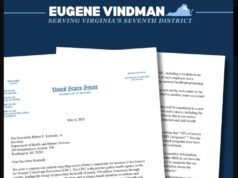(This budget proposal makes a great deal of sense, which of course means the “Gang of Six” et al won’t ever support it. – promoted by lowkell)
Congress returns to Washington, DC this week, and with it returns the debate over the FY2012 budget. Frustrated with the focus on downsizing government and seeing a void of budget proposals that reflect their vision for the country, progressive members of Congress crafted the subject of this week’s 90 Second Summary: The People’s Budget.
With new episodes each Monday, 90 Second Summaries provides simple, concise explanations of bills in front of Congress. This week’s episode focuses upon an alternative to both President Barack Obama’s and Congressman Paul Ryan’s budgets. However, as seems to be the case with any “adult conversation” these days, the Beltway press assumes that progressives will be seated at the kids table.
If nothing else, the People’s Budget represents something radically different from the “austerity” measures proposed by the President and Congressman Ryan. It shatters the conventional wisdom that the only option to fix the deficit is to mangle the social safety net. Yet its exclusion from the greater debate means many Americans will never hear what the proposal is.
While folks online are watching this summary, we will be personally delivering it to targeted offices on Capitol Hill. The People’s Budget was never intended to pass on its own, but rather to influence the debate. Our goal is to make a splash today and increase understanding of the People’s Budget.
Please help us spread word about this week’s episode: The People’s Budget.
90 Second Summaries: Season 2, Episode 11
The People’s Budget:
FY2012 Congressional Progressive Caucus Budget Proposal
Released 4/7/2011
Click here to download this summary (pdf)
Status: Offered on 4/15/11 as a substitute amendment to the House FY12 Budget Resolution (H.CON.RES. 34). Failed by a 77-347 margin. However, the proposal is designed primarily to generate media attention and influence the debate.
Purpose: During the 2010 election season, House Republicans promised to advance an austerity budget. This promise led to Paul Ryan’s “Path to Prosperity” proposal, which drastically cuts discretionary spending and Medicaid, cuts taxes on upper-income families and corporations, and privatizes Medicare into a voucher system. President Obama’s budget, meanwhile, is more moderate by nature; it offers modest spending cuts and phases out some of the Bush tax cuts, but is limited in its deficit reduction impact. Frustrated with the focus on austerity and seeing a void of budget proposals that reflect their vision for the country, progressive members of Congress crafted The People’s Budget as an alternative.
Summary: The People’s Budget yields a surplus of $30.7 billion and stabilizes the debt at 64.1% by FY2021, a level lower than even the Ryan budget. It does so through the following changes:
1) Raises $3.9 trillion in new revenue over ten years by:
• Immediately rescinding the upper-income tax cuts from December’s tax cut deal and letting the upper-income Bush tax cuts expire at the end of 2012;
• Enacting new income tax brackets that range from 45% starting at $1 million to 49% on $1 billion and over;
• Taxing all capital gains and dividend income as ordinary income;
• Capping deductibility of itemized deductions at 28% (as proposed by President Obama in 2009);
• Enacting a financial speculation tax on derivatives and foreign exchange transactions, and a special fee on large banks to cover the cost of future bailouts;
• Making the estate tax more progressive by adopting a $3.5 million exemption, 45% rate up to $50M, 55% up to $500M, and 65% for the portion of estates valued over $500 million;
• Closing tax loopholes for multinational corporations by taxing their income as it is earned.2) Cuts $1.7 trillion in spending over ten years by:
• Eliminating tax subsidies for fossil fuel companies;
• Enacting a public health insurance option and negotiating prescription drug costs with pharmaceutical companies;
• Ending the wars in Afghanistan and Iraq and decreasing baseline defense spending;
• Saving $856 billion in interest payments on the debt over the next decade as a result of the lower deficit levels.3) Makes targeted investments to spur economic recovery:
• $1.45 trillion over 10 years, primarily for education and job training, renewable energy, health, housing and veterans benefits;
• An infrastructure bank designed to leverage private sector investment in transportation, water and energy projects;
• A large increase ($213 billion overall) in the funding provided by a surface transportation reauthorization bill.4) Ensures Social Security solvency for the next 75 years through increased revenues:
• For the half of the payroll tax paid by employees, adjusting the taxable maximum to equal 90% of total payroll;
• For the half of the payroll tax paid by employers, eliminating the maximum income level subject to taxation entirely.
Supporters: Most of the Congressional Progressive Caucus and allied organizations
• Supporters tout this proposal’s ability to balance the budget in a realistic fashion while stimulating future economic prosperity without harming the social safety net, Medicare or Social Security. They also claim it returns fairness to the tax code by placing more of the burden on the rich and corporations.
Opponents: The rest of the political establishment
• In general, opponents either outright dislike most or all of the tax measures contained in this proposal, or dismiss them as politically unrealistic.
Further links
Official CPC executive summary: http://grijalva.house.gov/uploads/The%20CPC%20FY2012%20Budget.pdf
EPI analysis of the People’s Budget: http://grijalva.house.gov/uploads/The%20People%27s%20Budget%20-%20A%20Technical%20Analysis.pdf
Summary of House GOP Budget Resolution (Ryan Budget): http://budget.house.gov/UploadedFiles/PathToProsperityFY2012.pdf
HuffPo article on the Schakowsky income tax proposal: http://www.huffingtonpost.com/2011/03/16/jan-schakowsky-income-tax_n_836624.html
Economist article comparing the Ryan and CPC budget proposals: http://www.economist.com/blogs/democracyinamerica/2011/04/debt_proposals














![Monday News: Trump’s Lunacy Pushes China, Russia, India, etc. Together; “Happy Labor Day. Donald Trump and Elon Musk Are Screwing Workers.”; “Where is the [media’s] intense focus on Trump’s failing health?”; ““Trump says he is not a dictator. Isn’t he?”](https://bluevirginia.us/wp-content/uploads/2025/09/montage0901-100x75.jpg)